A Short Review of Through-Silicon via (TSV) Interconnects: Metrology and Analysis
Abstract
1. Introduction
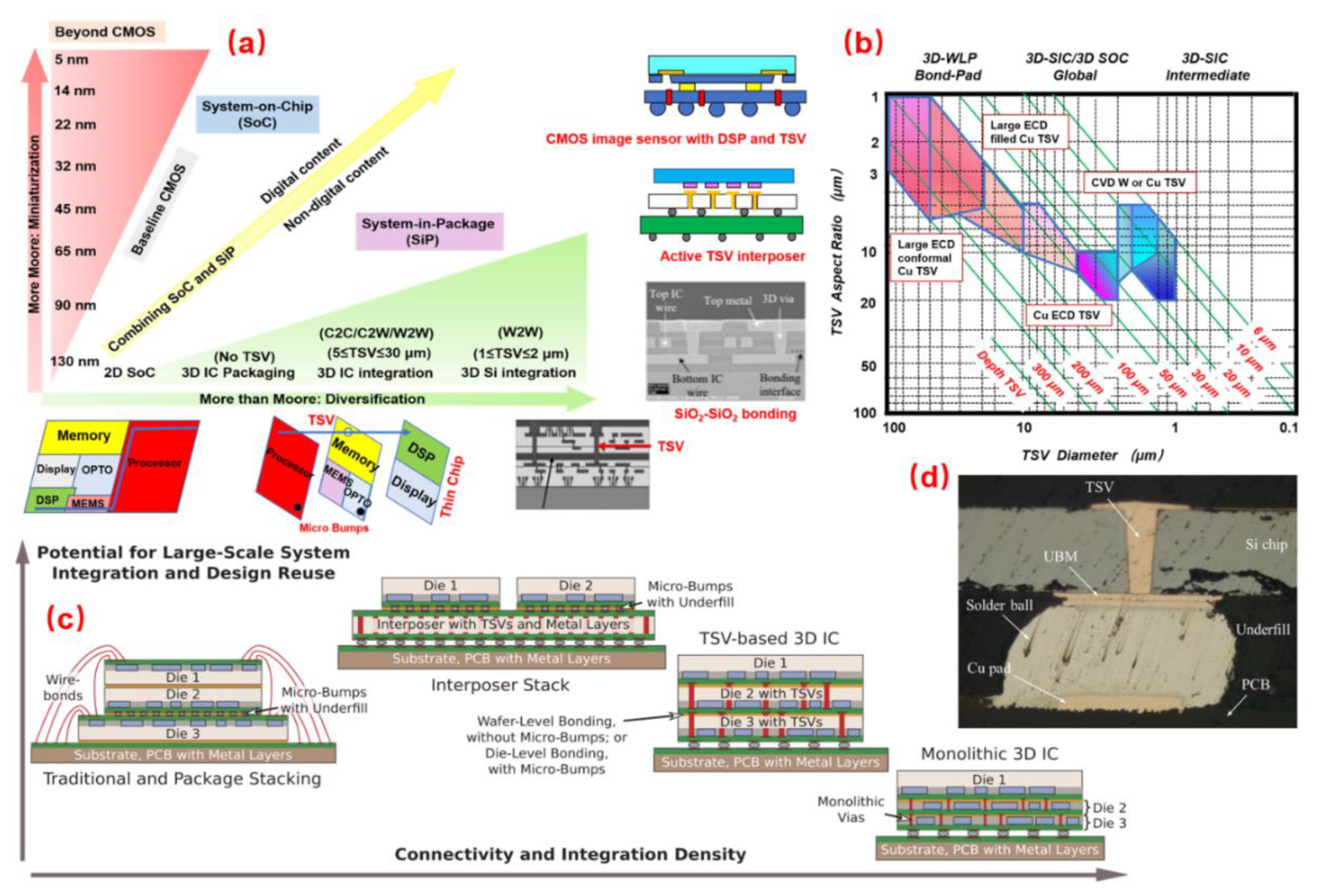
2. TSV Metrology
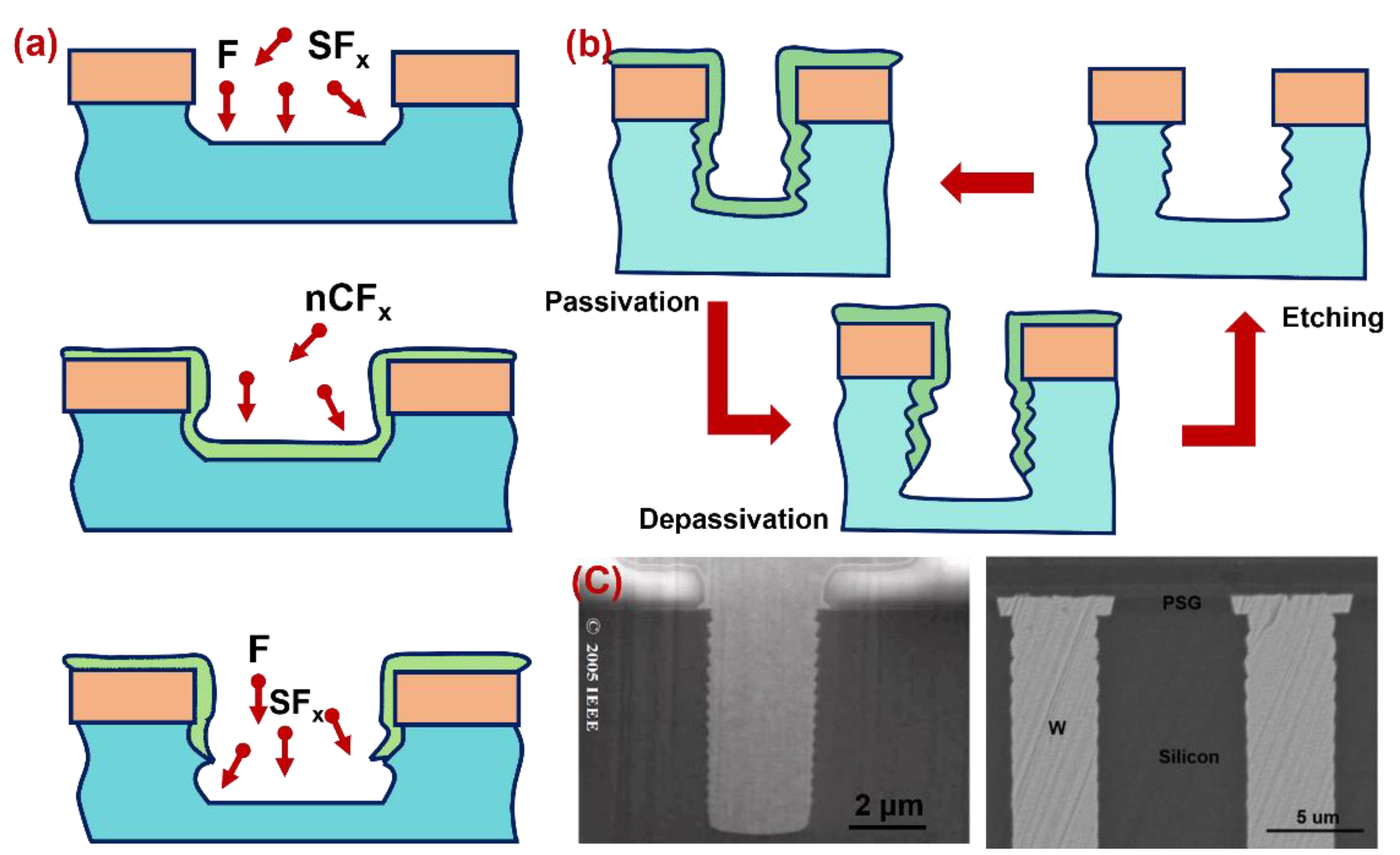
2.1. Profile

2.2. Metal Fill
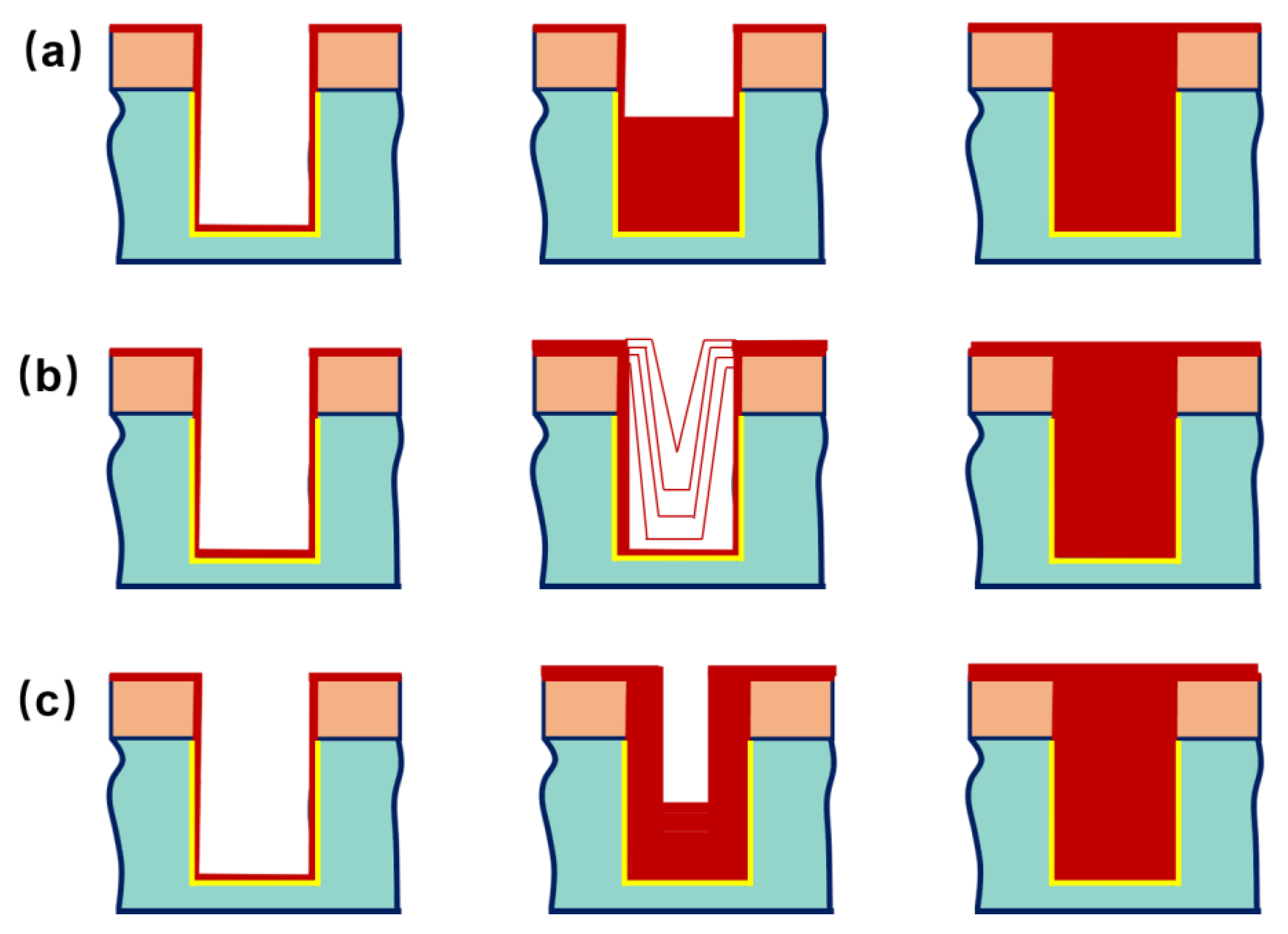
| hTSV (nm) | %Change in Vrosstalk Delay of Defected Conditions w.r.t Defect Free Condition | |||||||
|---|---|---|---|---|---|---|---|---|
| Air Crack with Connector | Spherical AIR Void | |||||||
| Rcon = 1.05 nm | Rcon = 2.10 nm | Rcon = 4.20 nm | Rcon = 5.04 nm | Rhole = 1.05 nm | Rhole = 2.10 nm | Rhole = 4.20 nm | Rhole = 5.04 nm | |
| 30 | −1.3 | −0.2 | −0.14 | −0.12 | 1.0 | 0.6 | −1.6 | −3.9 |
| 60 | −1.7 | −1.3 | −0.37 | −0.16 | 1.1 | 0.7 | −1.3 | −2.9 |
| 90 | −1.6 | −0.7 | −0.28 | −0.09 | 1.2 | 0.8 | −0.9 | −1.7 |
| 120 | −1.5 | −0.5 | −0.16 | −0.03 | 1.3 | 0.9 | −0.2 | −0.6 |
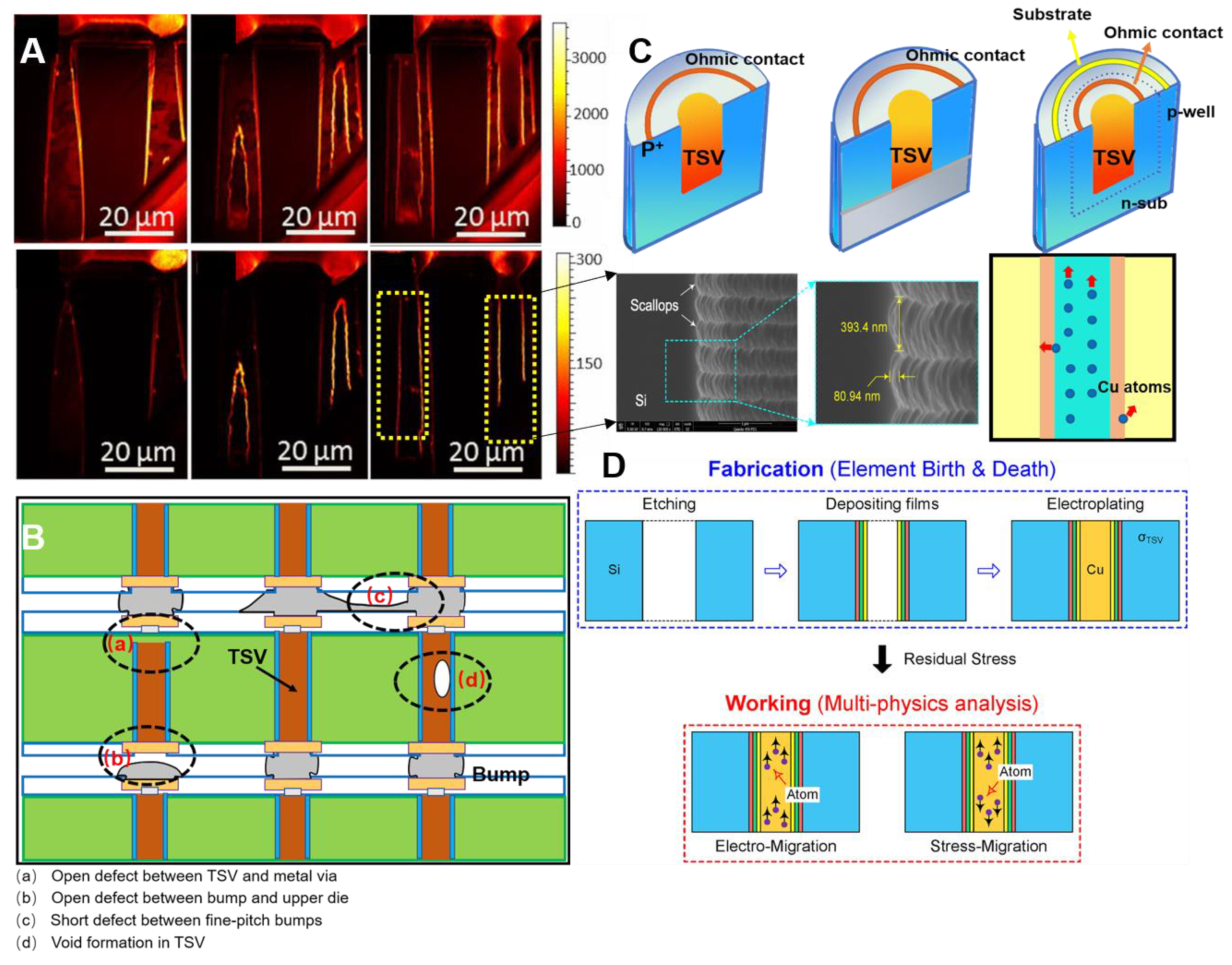
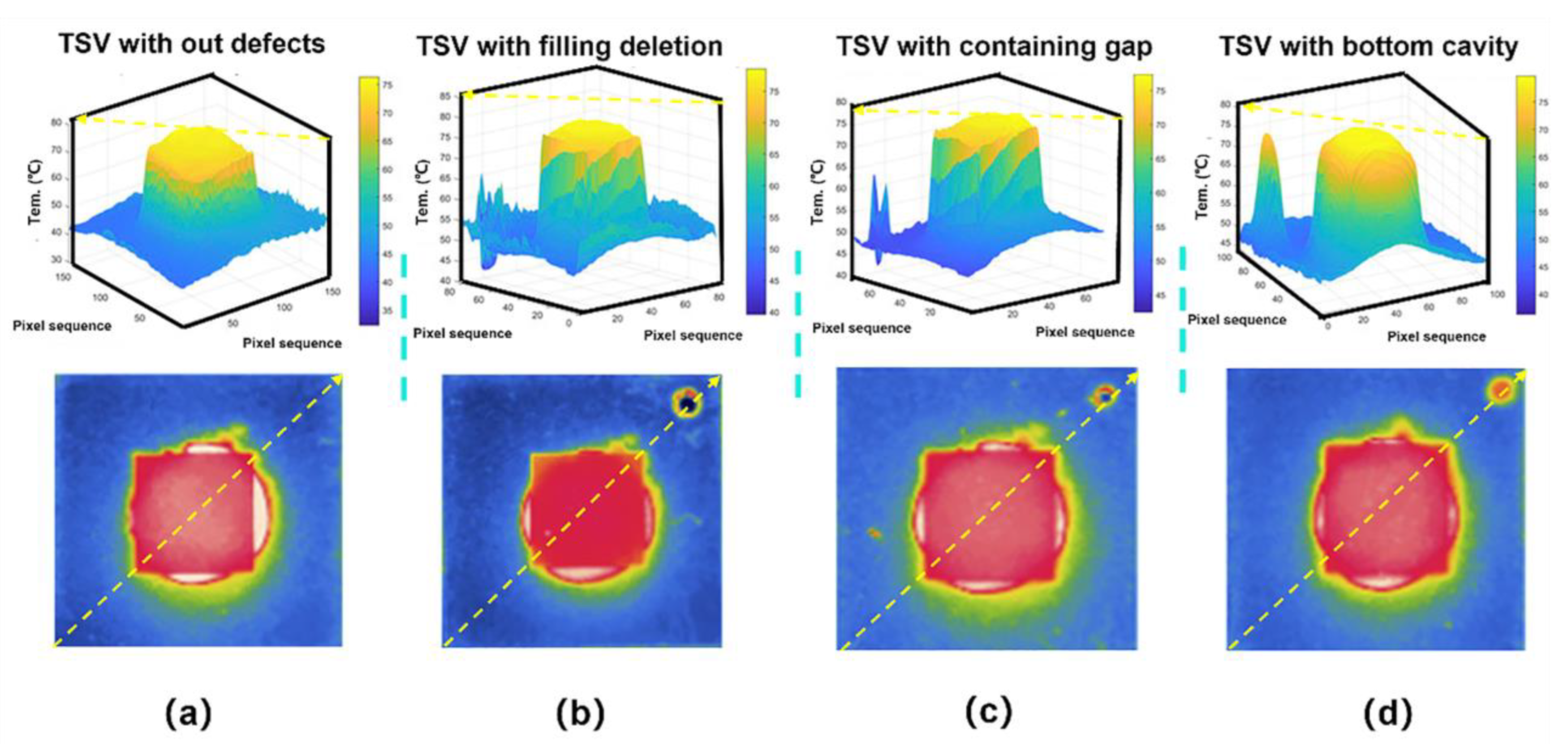
2.3. Electric-Field (E-Field) and Keep-Out Zone (KOZ)


3. TSV Reliability
3.1. Copper Contamination
3.2. Thermal Management
- (1)
- TSV Resistor
- (2)
- TSV Inductor
- (3)
- TSV Capacitor
- (4)
- TSV Conductance
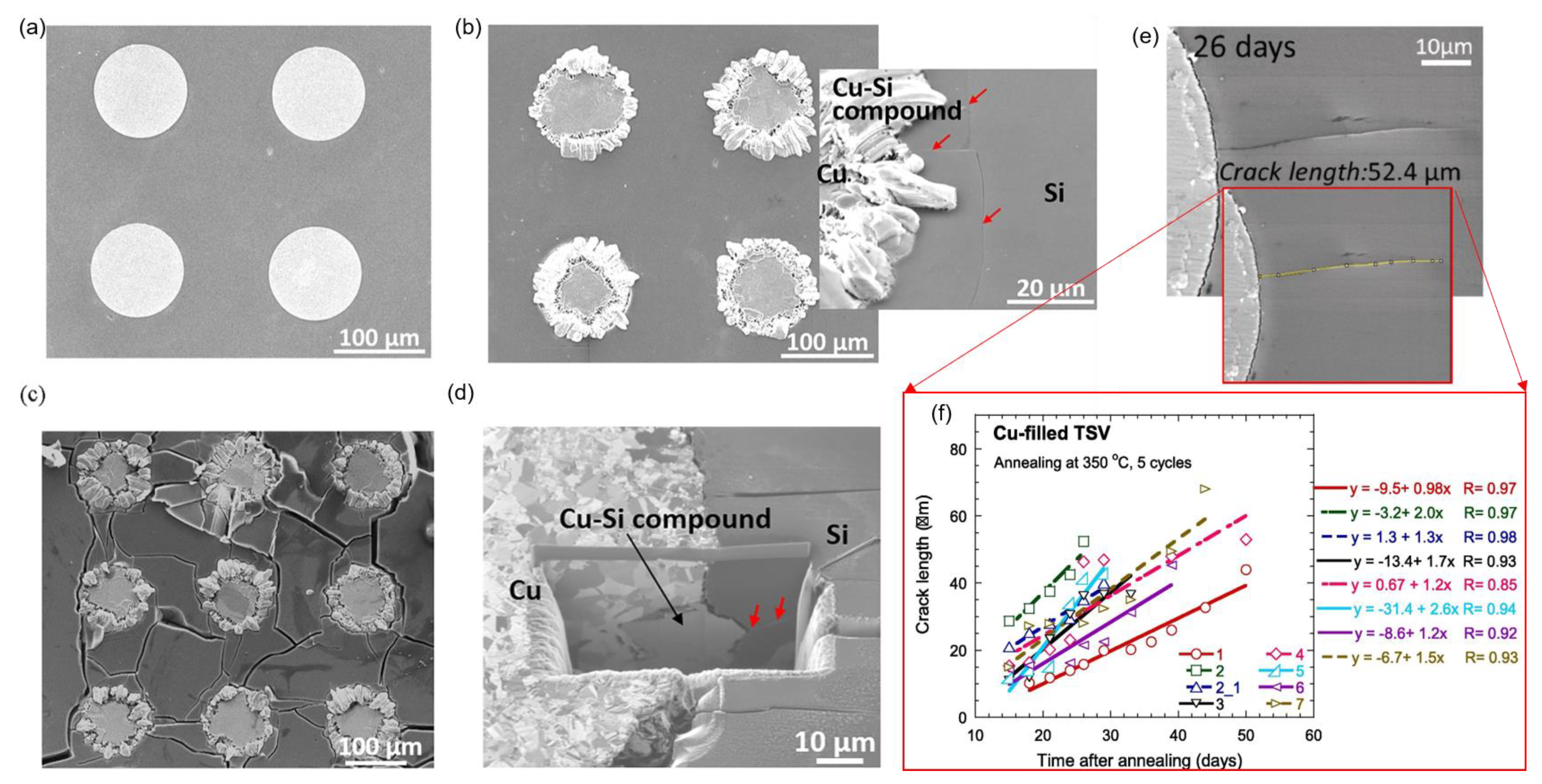
3.3. Stresses
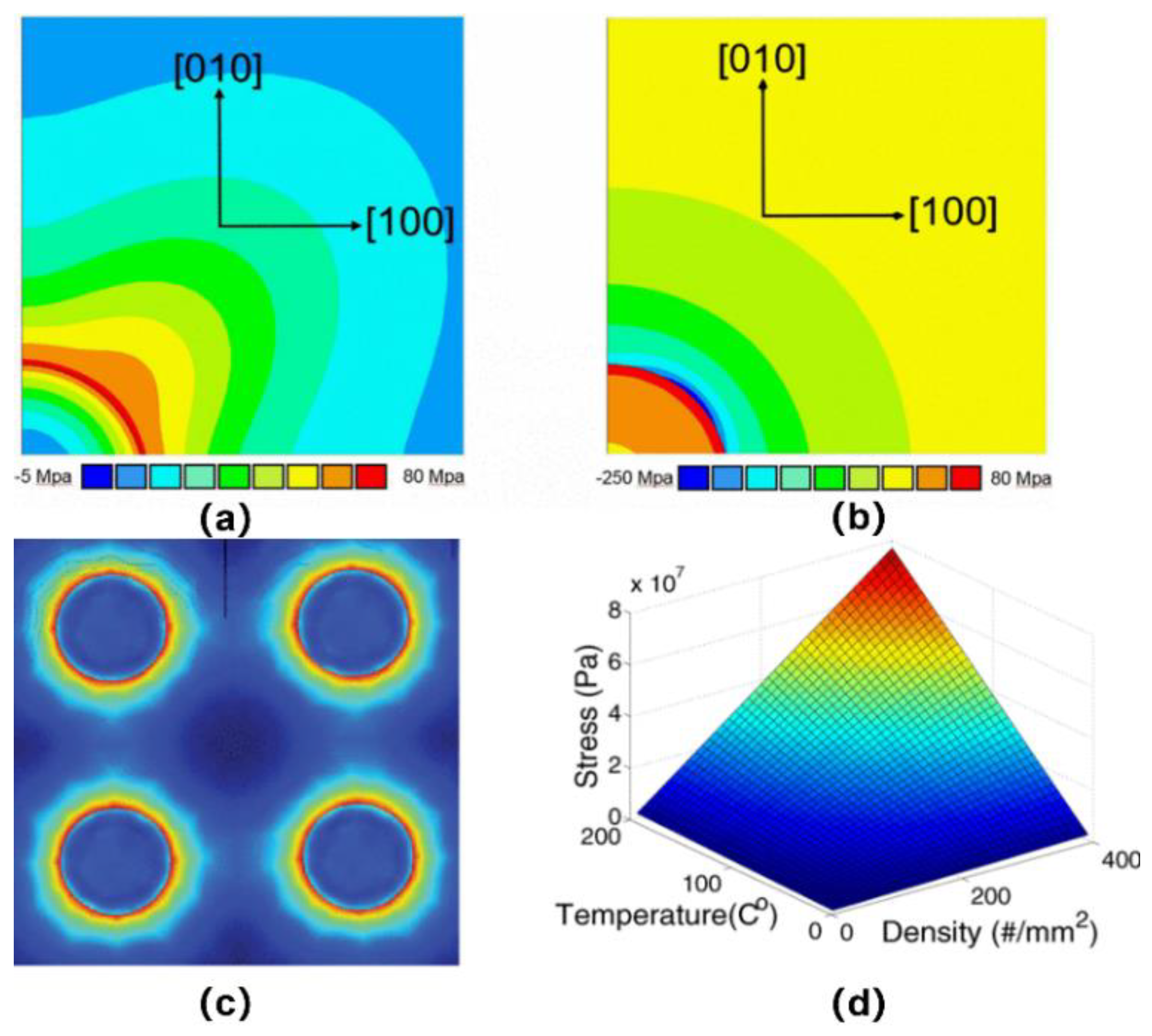
3.4. Noise Coupling
| Parameter | Via-First | Via-Middle | Via-Last |
|---|---|---|---|
| Diameter (μm) | 4 | 4 | 10 |
| Pitch (μm) | 8 | 8 | 20 |
| Length (μm) | 10 | 60 | 60 |
| TSV resistance (Ω) | 5.7 | 0.9 | 0.02 |
| TSV inductance (pH) | 4.2 | 49.8 | 34.9 |
| TSV coupling capacitance (fF) | 1.2 | 6.7 | 6 |
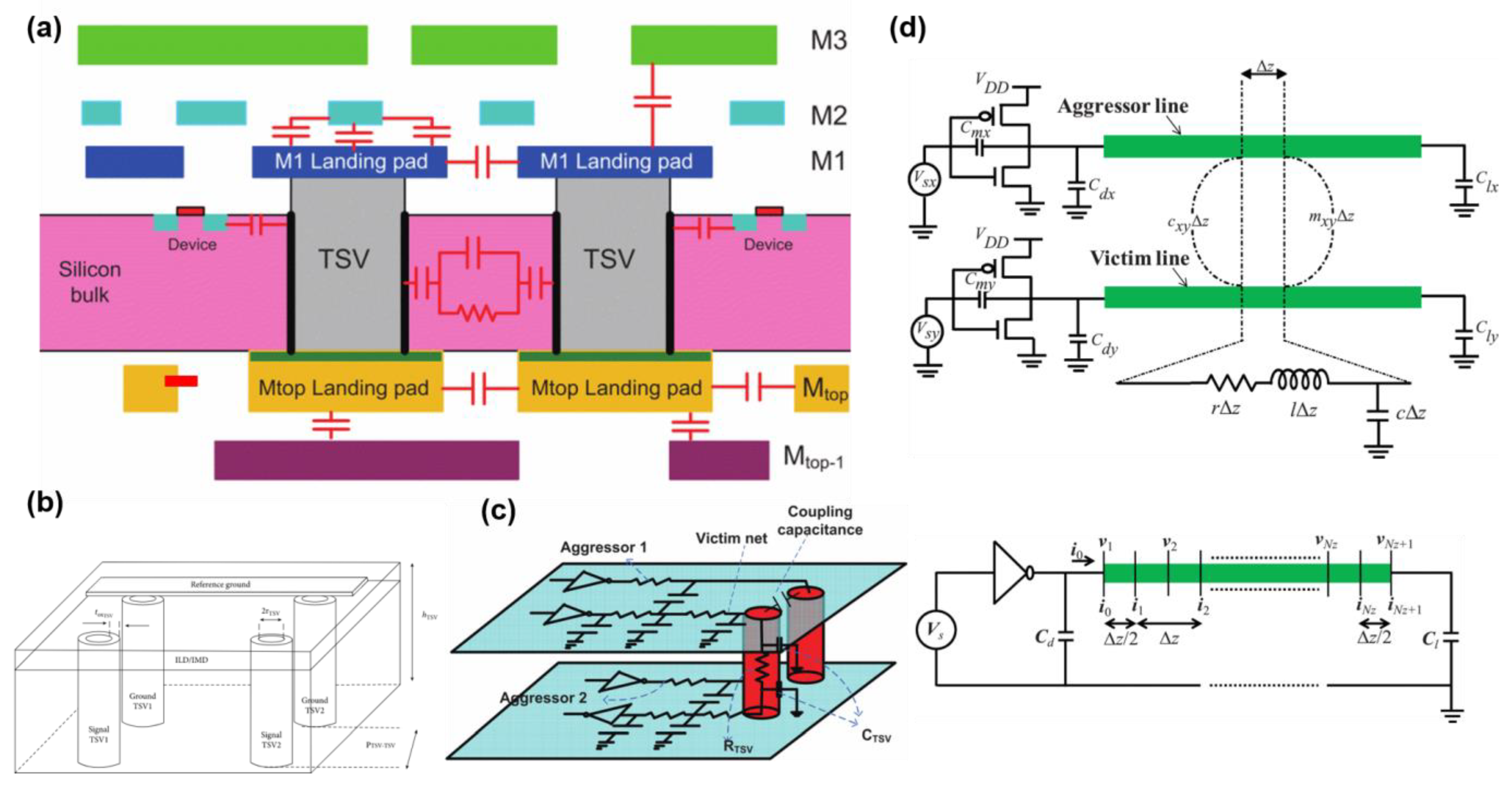
4. Outlook
4.1. New Etching Techniques
4.2. New Design Tools and Approaches
| hTSV | RTSV | Equivalent Circuit | Insertion Loss S21 | Reference | |
|---|---|---|---|---|---|
| MW-CNT TSV | 100 μm | 10 μm |  | −0.1 dB (20 GHz) | [83] |
| Elliptic cylindrical TSV | 60 μm | 2.5 μm 7.5 μm | −0.6 dB (20 GHz) | [84] | |
| CMF-TSV | 100 μm | 10 μm |  | −16.8 dB (3.5 GHz) | [85] |
| Tapered TSV | 50 μm | 0.17 μm (min) 0.52 μm (max) |  | −0.18 dB (20 GHz) | [86] |
| PI-TSV | 300 μm | 30 μm |  | −2.63 dB (2.4 GHz) | [87] |
| 32 nm with regard to TSV | 9.6 μm | 2 μm |  | 32.16% improvement (20 GHz) | [88] |
5. Conclusions
Author Contributions
Funding
Institutional Review Board Statement
Informed Consent Statement
Data Availability Statement
Conflicts of Interest
References
- Belaid, K.A.; Belahrach, H.; Ayad, H. Genetic Algorithms and Particle Swarm Optimization Mechanisms for Through-Silicon Via (TSV) Noise Coupling. Appl. Comput. Intell. Soft Comput. 2021, 2021, 1–14. [Google Scholar] [CrossRef]
- Lin, P.; Xie, X.; Wang, Y.; Lian, B.; Zhang, G. A multi-step etch method for fabricating slightly tapered through-silicon vias based on modified Bosch process. Microsyst. Technol. 2018, 25, 2693–2698. [Google Scholar] [CrossRef]
- Serafy, C.; Shi, B.; Srivastava, A. A geometric approach to chip-scale TSV shield placement for the reduction of TSV coupling in 3D-ICs. Integration 2014, 47, 307–317. [Google Scholar] [CrossRef]
- Vianne, B.; Richard, M.-I.; Escoubas, S.; Labat, S.; Schülli, T.; Chahine, G.; Fiori, V.; Thomas, O. Through-silicon via-induced strain distribution in silicon interposer. Appl. Phys. Lett. 2015, 106, 141905. [Google Scholar] [CrossRef]
- Luo, J.; Sun, Y.; Wang, B.; Jin, Z.; Yang, S.; Wang, Y.; Ding, G. Elastic and elastic-plastic analysis of multilayer thin films filled with heterogeneous materials. AIP Adv. 2018, 8, 115134. [Google Scholar] [CrossRef]
- Lau, J.H. Overview and outlook of through-silicon via (TSV) and 3D integrations. Microelectron. Int. 2011, 28, 8–22. [Google Scholar] [CrossRef]
- Sonawane, D.; Kumar, P. New insights into fracture of Si in Cu-filled through silicon via during and after thermal annealing. Eng. Fract. Mech. 2020, 238, 107281. [Google Scholar] [CrossRef]
- Lai, M.-F.; Li, S.-W.; Shih, J.-Y.; Chen, K.-N. Wafer-level three-dimensional integrated circuits (3D IC): Schemes and key technologies. Microelectron. Eng. 2011, 88, 3282–3286. [Google Scholar] [CrossRef]
- Wang, X.; Chen, D.; Li, D.; Kou, C.; Yang, Y. The Development and Progress of Multi-Physics Simulation Design for TSV-Based 3D Integrated System. Symmetry 2023, 15, 418. [Google Scholar] [CrossRef]
- Gambino, J.P.; Adderly, S.A.; Knickerbocker, J.U. An overview of through-silicon-via technology and manufacturing challenges. Microelectron. Eng. 2015, 135, 73–106. [Google Scholar] [CrossRef]
- Yoon, H.; Choi, K.-S.; Bae, H.-C.; Moon, J.-T.; Eom, Y.-S.; Jeon, I. Evaluating the material properties of underfill for a reliable 3D TSV integration package using numerical analysis. Microelectron. Reliab. 2017, 71, 41–50. [Google Scholar] [CrossRef]
- Knechtel, J.; Sinanoglu, O.; Elfadel, I.M.; Lienig, J.; Sze, C.C.N. Large-Scale 3D Chips: Challenges and Solutions for Design Automation, Testing, and Trustworthy Integration. IPSJ Trans. Syst. LSI Des. Methodol. 2017, 10, 45–62. [Google Scholar] [CrossRef]
- Karmarkar, A.P.; Xu, X.; El Sayed, K.; Guo, W.; Van der Plas, G.; Van Huylenbroeck, S.; Gonzalez, M.; Absil, P.; Beyne, E. Modeling Copper Plastic Deformation and Liner Viscoelastic Flow Effects on Performance and Reliability in Through Silicon Via (TSV) Fabrication Processes. IEEE Trans. Device Mater. Reliab. 2019, 19, 642–653. [Google Scholar] [CrossRef]
- Kim, J.H.; Yoo, W.S.; Han, S.M. Non-destructive micro-Raman analysis of Si near Cu through silicon via. Electron. Mater. Lett. 2017, 13, 120–128. [Google Scholar] [CrossRef]
- Frank, T.; Moreau, S.; Chappaz, C.; Leduc, P.; Arnaud, L.; Thuaire, A.; Chery, E.; Lorut, F.; Anghel, L.; Poupon, G. Reliability of TSV interconnects: Electromigration, thermal cycling, and impact on above metal level dielectric. Microelectron. Reliab. 2012, 53, 17–29. [Google Scholar] [CrossRef]
- Barnes, J.-P.; Djomeni, L.; Minoret, S.; Mourier, T.; Fabbri, J.-M.; Audoit, G.; Fadloun, S. Focused ion beam time-of-flight secondary ion mass spectroscopy tomography of through-silicon vias for 3D integration. J. Vac. Sci. Technol. B 2016, 34, 03H137. [Google Scholar] [CrossRef]
- Bea, J.; Lee, K.; Fukushima, T.; Tanaka, T.; Koyanagi, M. Evaluation of Cu Diffusion from Cu Through-Silicon Via (TSV) in Three-Dimensional LSI by Transient Capacitance Measurement. IEEE Electron Device Lett. 2011, 32, 940–942. [Google Scholar] [CrossRef]
- Sun, Y.; Sun, S.; Zhang, Y.; Luo, J.; Wang, Y.; Ding, G.; Jin, Y. Initial thermal stress and strain effects on thermal mechanical stability of through silicon via. Microelectron. Eng. 2016, 165, 11–19. [Google Scholar] [CrossRef]
- Nabil, A.; Bernardo, J.A.; Ma, Y.; Abouelatta, M.; Shaker, A.; Bouchet, L.F.; Ragai, H.; Gontrand, C. Electrical modeling of tapered TSV including MOS-Field effect and substrate parasitics: Analysis and application. Microelectron. J. 2020, 100, 104797. [Google Scholar] [CrossRef]
- Xiao, H.; He, H.; Ren, X.; Zeng, P.; Wang, F. Numerical modeling and experimental verification of copper electrodeposition for through silicon via (TSV) with additives. Microelectron. Eng. 2017, 170, 54–58. [Google Scholar] [CrossRef]
- Jung, D.H.; Kim, Y.; Kim, J.J.; Kim, H.; Choi, S.; Song, Y.-H.; Bae, H.-C.; Choi, K.-S.; Piersanti, S.; de Paulis, F.; et al. Through Silicon Via (TSV) Defect Modeling, Measurement, and Analysis. IEEE Trans. Compon. Packag. Manuf. Technol. 2017, 7, 138–152. [Google Scholar] [CrossRef]
- Guo, H.; Cao, S.; Li, L.; Zhang, X. A review on the mainstream through-silicon via etching methods. Mater. Sci. Semicond. Process. 2022, 137, 106182. [Google Scholar] [CrossRef]
- Fursenko, O.; Bauer, J.; Marschmeyer, S.; Stoll, H.-P. Through silicon via profile metrology of Bosch etching process based on spectroscopic reflectometry. Microelectron. Eng. 2015, 139, 70–75. [Google Scholar] [CrossRef]
- Shen, W.-W.; Chen, K.-N. Three-Dimensional Integrated Circuit (3D IC) Key Technology: Through-Silicon Via (TSV). Nanoscale Res. Lett. 2017, 12, 56. [Google Scholar] [CrossRef]
- Ehsan, M.A.; Zhou, Z.; Yi, Y. Electrical modeling and analysis of sidewall roughness of through silicon vias in 3D integration. In Proceedings of the IEEE International Symposium on Electromagnetic Compatibility (EMC), Raleigh, NC, USA, 4–8 August 2014; pp. 52–56. [Google Scholar]
- Zhou, J.; Wan, L.; Dai, F.; Wang, H.; Song, C.; Du, T.; Chu, Y.; Pan, M.; Guidotti, D.; Cao, L.; et al. Accurate electrical simulation and design optimization for silicon interposer considering the MOS effect and eddy currents in the silicon substrate. In Proceedings of the IEEE 62nd Electronic Components and Technology Conference, San Diego, CA, USA, 29 May–1 June 2012; pp. 658–664. [Google Scholar]
- Li, Y.; Srinath, P.K.M.; Goyal, D. A Review of Failure Analysis Methods for Advanced 3D Microelectronic Packages. J. Electron. Mater. 2015, 45, 116–124. [Google Scholar] [CrossRef]
- Pan, Y.; Li, F.; He, H.; Li, J.; Zhu, W. Effects of dimension parameters and defect on TSV thermal behavior for 3D IC packaging. Microelectron. Reliab. 2017, 70, 97–102. [Google Scholar] [CrossRef]
- Peng, B.; Hou, W.; Xu, Q. Precision 3D profile in-line measurement of through-silicon via (TSV) based on high-frequency spectrum signals in the pupil plane. Opt. Commun. 2018, 424, 107–112. [Google Scholar] [CrossRef]
- Huang, Y.-J.; Pan, C.-L.; Lin, S.-C.; Guo, M.-H. Machine-Learning Approach in Detection and Classification for Defects in TSV-Based 3-D IC. IEEE Trans. Compon. Packag. Manuf. Technol. 2018, 8, 699–706. [Google Scholar] [CrossRef]
- Yi, M.; Bian, J.; Ni, T.; Jiang, C.; Chang, H.; Liang, H. A Pulse Shrinking-Based Test Solution for Prebond Through Silicon via in 3-D Ics. IEEE Trans. Comput. Aided Des. Integr. Circuits Syst. 2019, 38, 755–766. [Google Scholar] [CrossRef]
- Hsu, C.-L.; Tsai, J.-Y.; Hsueh, T.-J. Novel field emission structure of CuO/Cu2O composite nanowires based on copper through silicon via technology. RSC Adv. 2015, 5, 33762–33766. [Google Scholar] [CrossRef]
- Chandrakar, M.; Majumder, M.K. Performance Analysis Using Air Gap Defected Through Silicon Via: Impact on Crosstalk and Power. IEEE Trans. Compon. Packag. Manuf. Technol. 2022, 12, 1832–1840. [Google Scholar] [CrossRef]
- Noia, B.; Panth, S.; Chakrabarty, K.; Lim, S.K. Scan Test of Die Logic in 3-D ICs Using TSV Probing. IEEE Trans. Very Large Scale Integr. (VLSI) Syst. 2015, 23, 317–330. [Google Scholar] [CrossRef]
- Cheng, Z.; Ding, Y.; Xiao, L.; Yang, B.; Chen, Z. Study on atomic migration of copper through-silicon-vias with Bosch scallops. Microelectron. Reliab. 2021, 123, 114178. [Google Scholar] [CrossRef]
- Nie, L.; Huang, Y.; Liu, M. Internal defects inspection of TSV 3D package based on thermal distribution analysis. AIP Adv. 2021, 11, 085312. [Google Scholar] [CrossRef]
- Nair, R.K.R.; Pothiraj, S.; Nair, T.R.R.; Cengiz, K. An efficient partitioning and placement based fault TSV detection in 3D-IC using deep learning approach. J. Ambient. Intell. Humaniz. Comput. 2021, 1–14. [Google Scholar] [CrossRef]
- Bandyopadhyay, T.; Han, K.J.; Chung, D.; Chatterjee, R.; Swaminathan, M.; Tummala, R. Rigorous Electrical Modeling of Through Silicon Vias (TSVs) With MOS Capacitance Effects. IEEE Trans. Components, Packag. Manuf. Technol. 2011, 1, 893–903. [Google Scholar] [CrossRef]
- Kim, K.; Choi, J.; Woo, S.; Cho, J.; Ahn, S. E-field induced keep-out zone determination method of through-silicon vias for 3-D ICs. Microelectron. Reliab. 2019, 98, 161–164. [Google Scholar] [CrossRef]
- Monticeli, F.M.; Shiino, M.Y.; Voorwald, H.J.C.; Cioffi, M.O.H. The synergy effect of carbon/glass/epoxy hybrid laminate in Mode I delamination: A physical microfracture analysis. Eng. Fract. Mech. 2020, 239, 107295. [Google Scholar] [CrossRef]
- Li, Y.; Van Huylenbroeck, S.; Roussel, P.; Brouri, M.; Gopinath, S.; Anjos, D.M.; Thorum, M.; Yu, J.; Beyer, G.P.; Beyne, E.; et al. Dielectric liner reliability in via-middle through silicon vias with 3 Micron diameter. Microelectron. Eng. 2016, 156, 37–40. [Google Scholar] [CrossRef]
- Frank, T.; Chappaz, C.; Leduc, P.; Arnaud, L.; Lorut, F.; Moreau, S.; Thuaire, A.; El Farhane, R.; Anghel, L. Resistance increase due to electromigration induced depletion under TSV. In Proceedings of the International Reliability Physics Symposium, Monterey, CA, USA, 10–14 April 2011; pp. 3F.4.1–3F.4.6. [Google Scholar] [CrossRef]
- Chang, N.; Chung, C.K.; Wang, Y.-P.; Lin, C.F.; Su, P.; Shih, T.; Kao, N.; Hung, J. 3D Micro Bump Interface Enabling Top Die Interconnect to True Circuit Through Silicon Via Wafer. In Proceedings of the IEEE 70th Electronic Components and Technology Conference (ECTC), Orlando, FL, USA, 3–30 June 2020; pp. 1888–1893. [Google Scholar] [CrossRef]
- Choi, H.-J.; Choi, S.-M.; Yeo, M.-S.; Cho, S.-D.; Baek, D.-C.; Park, J. An experimental study on the TSV reliability: Electromigration (EM) and time dependant dielectric breakdown (TDDB). In Proceedings of the IEEE International Interconnect Technology Conference, San Jose, CA, USA, 4–6 June 2012; pp. 1–3. [Google Scholar] [CrossRef]
- Salvi, S.S.; Jain, A. A Review of Recent Research on Heat Transfer in Three-Dimensional Integrated Circuits (3-D ICs). IEEE Trans. Compon. Packag. Manuf. Technol. 2021, 11, 802–821. [Google Scholar] [CrossRef]
- Shin, Y.; Kim, S.E.; Kim, S. Thermal assessment of copper through silicon via in 3D IC. Microelectron. Eng. 2016, 156, 2–5. [Google Scholar] [CrossRef]
- Zhao, X.; Ma, L.; Wang, Y.; Guo, F. Effect of Thermal Mechanical Behaviors of Cu on Stress Distribution in Cu-Filled Through-Silicon Vias Under Heat Treatment. J. Electron. Mater. 2017, 47, 142–147. [Google Scholar] [CrossRef]
- Song, M.; Wei, Z.; Wang, B.; Chen, L.; Szpunar, J.A. Study on copper protrusion of through-silicon via in a 3-D integrated circuit. Mater. Sci. Eng. A 2019, 755, 66–74. [Google Scholar] [CrossRef]
- Zhao, X.; Ma, L.; Wang, Y.; Guo, F. Mechanism of the Local Cu Protrusion in Cu-Filled Through Silicon Vias Under Heat Treatment. J. Electron. Mater. 2018, 48, 152–158. [Google Scholar] [CrossRef]
- Wang, S.; Yin, Y.; Hu, C.; Rezai, P. 3D Integrated Circuit Cooling with Microfluidics. Micromachines 2018, 9, 287. [Google Scholar] [CrossRef] [PubMed]
- Stiebing, M.; Vogel, D.; Steller, W.; Wolf, M.; Wunderle, B. Challenges in the reliability of 3D integration using TSVs. In Proceedings of the 16th International Conference on Thermal, Mechanical and Multi-Physics Simulation and Experiments in Microelectronics and Microsystems, Budapest, Hungary, 19–22 April 2015. [Google Scholar]
- Lee, W.-C.; Min, B.-W.; Kim, J.C.; Yook, J.-M. Silicon-core Coaxial Through Silicon Via for Low-loss RF Si-interposer. IEEE Microw. Wirel. Components Lett. 2017, 27, 428–430. [Google Scholar] [CrossRef]
- Sai, M.P.D.; Hao, Y.; Yang, S.; Seng, T.C.; Kyu, L.S. Reliable 3-D Clock-Tree Synthesis Considering Nonlinear Capacitive TSV Model with Electrical–Thermal–Mechanical Coupling. IEEE Trans. Comput. Aided Des. Integr. Circuits Syst. 2013, 32, 1734–1747. [Google Scholar] [CrossRef]
- Chen, C.-F.; Wu, S.-T. Equivalent mechanical properties of through silicon via interposers—A unit model approach. Microelectron. Reliab. 2015, 55, 221–230. [Google Scholar] [CrossRef]
- Xia, K.; Zhu, Z.; Zhang, H.; Xu, Z. Modeling simplification for thermal mechanical stress analysis of TSV interposer stack. Microelectron. Reliab. 2019, 96, 46–50. [Google Scholar] [CrossRef]
- Chen, S.; En, Y.F.; Li, G.Y.; Wang, Z.Z.; Gao, R.; Ma, R.; Zhang, L.X.; Huang, Y. An ion beam layer removal method of determining the residual stress in the as-fabricated TSV-Cu/TiW/SiO2/Si interface on a nanoscale. Microelectron. Reliab. 2020, 112, 113826. [Google Scholar] [CrossRef]
- Cho, Y.; Shafiei, F.; Mendoza, B.S.; Lei, M.; Jiang, T.; Ho, P.S.; Downer, M.C. Second-harmonic microscopy of strain fields around through-silicon-vias. Appl. Phys. Lett. 2016, 108, 151602. [Google Scholar] [CrossRef]
- Satheesh, S.M.; Salman, E. Power Distribution in TSV-Based 3-D Processor-Memory Stacks. IEEE J. Emerg. Sel. Top. Circuits Syst. 2012, 2, 692–703. [Google Scholar] [CrossRef]
- Xu, K.; Friedman, E.G. Scaling trends of power noise in 3-D ICs. Integration 2015, 51, 139–148. [Google Scholar] [CrossRef]
- Pragathi, D.; Prasad, D.; Padma, T.; Reddy, P.R.; Kumari, C.U.; Poola, P.K.; Panigrahy, A.K. An extensive survey on reduction of noise coupling in TSV based 3D IC integration. Mater. Today Proc. 2021, 45, 1471–1480. [Google Scholar] [CrossRef]
- Kumar, M.S.; Mohanraj, J.; Kumar, N.V.; Valliammai, M. An extensive survey on future direction for the reduction of noise coupling problem in TSV based 3-dimensional IC integration. Mater. Today Proc. 2021, 46, 3502–3511. [Google Scholar] [CrossRef]
- Kumar, V.R.; Kaushik, B.K.; Patnaik, A. An accurate model for dynamic crosstalk analysis of CMOS gate driven on-chip interconnects using FDTD method. Microelectron. J. 2014, 45, 441–448. [Google Scholar] [CrossRef]
- Kaushik, B.K.; Sarkar, S.; Agarwal, R.P.; Joshi, R.C. Crosstalk analysis of simultaneously switching interconnects. Int. J. Electron. 2009, 96, 1095–1114. [Google Scholar] [CrossRef]
- Kumar, V.R.; Alam, A.; Kaushik, B.K.; Patnaik, A. An Unconditionally Stable FDTD Model for Crosstalk Analysis of VLSI Interconnects. IEEE Trans. Compon. Packag. Manuf. Technol. 2015, 5, 1810–1817. [Google Scholar] [CrossRef]
- Kaushik, B.K.; Sarkar, S.; Agarwal, R.; Joshi, R. Effect of line resistance and driver width on crosstalk in coupled VLSI interconnects. Microelectron. Int. 2007, 24, 42–45. [Google Scholar] [CrossRef]
- Liu, C.; Song, T.; Lim, S.K. Signal integrity analysis and optimization for 3D ICs. In Proceedings of the 12th International Symposium on Quality Electronic Design, Santa Clara, CA, USA, 14–16 March 2011. [Google Scholar]
- Cho, J.; Song, E.; Yoon, K.; Pak, J.S.; Kim, J.; Lee, W.; Song, T.; Kim, K.; Lee, J.; Lee, H.; et al. Modeling and Analysis of Through-Silicon Via (TSV) Noise Coupling and Suppression Using a Guard Ring. IEEE Trans. Compon. Packag. Manuf. Technol. 2011, 1, 220–233. [Google Scholar] [CrossRef]
- Eid, E.; Lacrevaz, T.; Bermond, C.; Capraro, S.; Roullard, J.; Fléchet, B.; Cadix, L.; Farcy, A.; Ancey, P.; Calmon, F.; et al. Characterization and modeling of RF substrate coupling effects in 3D integrated circuit stacking. Microelectron. Eng. 2011, 88, 729–733. [Google Scholar] [CrossRef]
- Qu, C.; Ding, R.; Zhu, Z. High-Frequency Electrical Modeling and Characterization of Differential TSVs for 3-D Integration Applications. IEEE Microw. Wirel. Compon. Lett. 2017, 27, 721–723. [Google Scholar] [CrossRef]
- Song, T.; Liu, C.; Peng, Y.; Lim, S.K. Full-chip multiple TSV-to-TSV coupling extraction and optimization in 3D ICs. In Proceedings of the 50th ACM/EDAC/IEEE Design Automation Conference (DAC), Austin, TX, USA, 29 May–7 June 2013. [Google Scholar]
- Gaynor, B.D.; Hassoun, S. Simulation Methodology and Evaluation of Through Silicon Via (TSV)-FinFET Noise Coupling in 3-D Integrated Circuits. IEEE Trans. Very Large Scale Integr. (VLSI) Syst. 2015, 23, 1499–1507. [Google Scholar] [CrossRef]
- Kumar, P.; Dutta, I.; Huang, Z.; Conway, P. Microstructural and reliability issues of TSV. In 3D Microelectronic Packaging; Springer: Singapore, 2017; pp. 71–99. [Google Scholar] [CrossRef]
- Awadallah, F.A.; Al-Muhtaseb, S. Carbon Nanoparticles-Decorated Carbon Nanotubes. Sci. Rep. 2020, 10, 4878. [Google Scholar] [CrossRef]
- Kaushik, B.K.; Majumder, M.K.; Kumar, V.R. Carbon Nanotube Based 3-D Interconnects—A Reality or a Distant Dream. IEEE Circuits Syst. Mag. 2014, 14, 16–35. [Google Scholar] [CrossRef]
- Pang, Z.; Sun, X.; Wu, X.; Nie, Y.; Liu, Z.; Yue, L. Fabrication and application of carbon nanotubes/cellulose composite paper. Vacuum 2015, 122, 135–142. [Google Scholar] [CrossRef]
- Oba, Y.; De Messemaeker, J.; Tyrovouzi, A.M.; Miyamori, Y.; De Vos, J.; Wang, T.; Beyer, G.; Beyne, E.; De Wolf, I.; Croes, K. Effect of test structure on electromigration characteristics in three-dimensional through silicon via stacked devices. Jpn. J. Appl. Phys. 2015, 54, 05EE01. [Google Scholar] [CrossRef]
- Pandiaraj, K.; Sivakumar, P.; Prakash, K.J. Machine learning based effective linear regression model for TSV layer assignment in 3DIC. Microprocess. Microsyst. 2021, 83, 103953. [Google Scholar] [CrossRef]
- Ali, K.; Yahya, E.; Elrouby, A.; Ismail, Y. Library based macro-modeling methodology for Through Silicon Via (TSV) arbitrary arrays. Microelectron. J. 2015, 46, 1291–1303. [Google Scholar] [CrossRef]
- Zhang, W.; Gu, J.; Xu, G.; Luo, L.; Li, X. An optimized through-via bottom-up method for simultaneous-filling TSVS of different aspect-ratios and its potential application on high-frequency passive interposer. Microelectron. J. 2021, 101, 104798. [Google Scholar] [CrossRef]
- Van Olmen, J.; Huyghebaert, C.; Coenen, J.; Van Aelst, J.; Sleeckx, E.; Van Ammel, A.; Armini, S.; Katti, G.; Vaes, J.; Dehaene, W.; et al. Integration challenges of copper Through Silicon Via (TSV) metallization for 3D-stacked IC integration. Microelectron. Eng. 2010, 88, 745–748. [Google Scholar] [CrossRef]
- Fan, Z.; Liu, Y.; Chen, X.; Jiang, Y.; Zhang, S.; Wang, Y. Research on fatigue of TSV-Cu under thermal and vibration coupled load based on numerical analysis. Microelectron. Reliab. 2020, 106, 113590. [Google Scholar] [CrossRef]
- Feng, W.; Watanabe, N.; Shimamoto, H.; Aoyagi, M.; Kikuchi, K. Stress investigation of annular-trench-isolated TSV by polarized Raman spectroscopy measurement and finite element simulation. Microelectron. Reliab. 2019, 99, 125–131. [Google Scholar] [CrossRef]
- Chan, Y.-C.; Basu, N.; Chen, T.-W.; Tsai, Y.-T.; Lin, H.-Y.; Chen, S.-C.; Lee, M.-H.; Liao, M.-H. The Analysis of Multiwall Carbon Nanotubes as Through Silicon Via by Equivalent Circuit Model at Different Operating Temperatures in Multilayers Stacking Scheme. IEEE Trans. Electron Devices 2023, 70, 3360–3364. [Google Scholar] [CrossRef]
- Guan, W.; Lu, H.; Zhang, Y.; Zhang, Y. The design and optimization of novel elliptic cylindrical through-silicon via and its temperature characterization. Eng. Rep. 2022, 4, e12470. [Google Scholar] [CrossRef]
- Li, Z.; Liu, H.; Sun, Y.; Yang, Y.; Miao, M.; Ma, S.; Jin, Y. TSV-based common-mode noise-suppressing filter design and implementation. Electron. Lett. 2022, 58, 243–245. [Google Scholar] [CrossRef]
- Chandrakar, S.; Gupta, D.; Majumder, M.K.; Kaushik, B.K. Performance Analysis of Bump in Tapered TSV: Impact on Crosstalk and Power Loss. IEEE Open J. Nanotechnol. 2022, 3, 227–235. [Google Scholar] [CrossRef]
- Dong, H.; Ding, Y.; Wang, H.; Pan, X.; Zhou, M.; Zhang, Z. Design of a Novel Compact Bandpass Filter Based on Low-Cost Through-Silicon-Via Technology. Micromachines 2023, 14, 1251. [Google Scholar] [CrossRef]
- Chandrakar, M.; Majumder, M.K. Impact of Polymer Liners on Crosstalk Induced Delay of Different TSV Shapes. IETE J. Res. 2022, 1–14. [Google Scholar] [CrossRef]
Disclaimer/Publisher’s Note: The statements, opinions and data contained in all publications are solely those of the individual author(s) and contributor(s) and not of MDPI and/or the editor(s). MDPI and/or the editor(s) disclaim responsibility for any injury to people or property resulting from any ideas, methods, instructions or products referred to in the content. |
© 2023 by the authors. Licensee MDPI, Basel, Switzerland. This article is an open access article distributed under the terms and conditions of the Creative Commons Attribution (CC BY) license (https://creativecommons.org/licenses/by/4.0/).
Share and Cite
Wang, J.; Duan, F.; Lv, Z.; Chen, S.; Yang, X.; Chen, H.; Liu, J. A Short Review of Through-Silicon via (TSV) Interconnects: Metrology and Analysis. Appl. Sci. 2023, 13, 8301. https://doi.org/10.3390/app13148301
Wang J, Duan F, Lv Z, Chen S, Yang X, Chen H, Liu J. A Short Review of Through-Silicon via (TSV) Interconnects: Metrology and Analysis. Applied Sciences. 2023; 13(14):8301. https://doi.org/10.3390/app13148301
Chicago/Turabian StyleWang, Jintao, Fangcheng Duan, Ziwen Lv, Si Chen, Xiaofeng Yang, Hongtao Chen, and Jiahao Liu. 2023. "A Short Review of Through-Silicon via (TSV) Interconnects: Metrology and Analysis" Applied Sciences 13, no. 14: 8301. https://doi.org/10.3390/app13148301
APA StyleWang, J., Duan, F., Lv, Z., Chen, S., Yang, X., Chen, H., & Liu, J. (2023). A Short Review of Through-Silicon via (TSV) Interconnects: Metrology and Analysis. Applied Sciences, 13(14), 8301. https://doi.org/10.3390/app13148301






